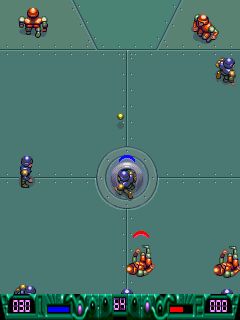Today, there are few alternatives to PCs and Microsoft: the OS Linux and the Macintosh made by Apple, with PowerPC processors. These alternatives are just for specialists in computer science and graphics; the dummies who buys a computer buys a Pentium architecture and installs Windows, because they do not know not even the existence of these alternatives.
 But
this had not been always true (and I
hope that it will not continue to
be true): in '80 - '90 decades we have seen the fast rise and the decline of an alternative system,
with hardware and software made by the same company: Amiga (that it is also acronym of Advanced Multitasking Integrated Graphic Architecture). This system
became a standard for videogames, with classics like Defender of the Crown, Sensible Soccer, Turrican, Kick Off, Speed Ball 2 , The Chaos Engine, Grand Prix, Lotus Turbo Challenge , but it has been also appreciated like machine for graphical applications.
Why? Because origin the engineers wanted to realize a machine for games, based
on the processor used in arcade machines, the Motorola 68000 (and the choice of this
processor made easy the conversions of videogames). But after the game crisis of the first '80es, the Amiga was sold as computer: 256 KB of RAM, 4096 colors,
real multitasking (IBM and Macintosh worked to the monochromatic one...). Amiga earned
a market, but after ten years...
But
this had not been always true (and I
hope that it will not continue to
be true): in '80 - '90 decades we have seen the fast rise and the decline of an alternative system,
with hardware and software made by the same company: Amiga (that it is also acronym of Advanced Multitasking Integrated Graphic Architecture). This system
became a standard for videogames, with classics like Defender of the Crown, Sensible Soccer, Turrican, Kick Off, Speed Ball 2 , The Chaos Engine, Grand Prix, Lotus Turbo Challenge , but it has been also appreciated like machine for graphical applications.
Why? Because origin the engineers wanted to realize a machine for games, based
on the processor used in arcade machines, the Motorola 68000 (and the choice of this
processor made easy the conversions of videogames). But after the game crisis of the first '80es, the Amiga was sold as computer: 256 KB of RAM, 4096 colors,
real multitasking (IBM and Macintosh worked to the monochromatic one...). Amiga earned
a market, but after ten years... But
something got broken. It's difficult to explain what is happened: modernization delays (the fixed disc for the Amiga was an
expensive optional) and other errors of marketing made to fail the Commodore , the company that had acquired Amiga. As we will see in the continuation, the escape of scene of the Amiga has not been due to a clean
architectural inferiority, a lot of fans continued to use Amiga, just upgrading their computers,
this allowed them emulating Macintosh and Windows 3.x, surfing the web, sending mail,
listening to mp3s, using graphical cards for PC... this has been possible thanks to expensive but efficient
cards with PowerPC processors.
But
something got broken. It's difficult to explain what is happened: modernization delays (the fixed disc for the Amiga was an
expensive optional) and other errors of marketing made to fail the Commodore , the company that had acquired Amiga. As we will see in the continuation, the escape of scene of the Amiga has not been due to a clean
architectural inferiority, a lot of fans continued to use Amiga, just upgrading their computers,
this allowed them emulating Macintosh and Windows 3.x, surfing the web, sending mail,
listening to mp3s, using graphical cards for PC... this has been possible thanks to expensive but efficient
cards with PowerPC processors. Currently, we hear of Amiga mother cards with PowerPC: this could sanction one overbearing rebirth of the Amiga and a renewal of the market, with lowering of prices, good for all. But why so much love for a little diffused system? Because the Amiga has represented a winning way to think the computer, because its hardware and its software had some features that only today we have on the PCs, as Gateway 2000, an important computer science company, said:
Since the introduction of the AMIGA 1000 in 1985, AMIGA has represented the embodiment of the efficient use of memory and hard drive capacity, while pioneering industry developments in multimedia, 32-bit multitasking and autoconfiguration. AMIGA led the industry in combining computer graphics, animation, and film sequences with stereo sound known today as multimedia.